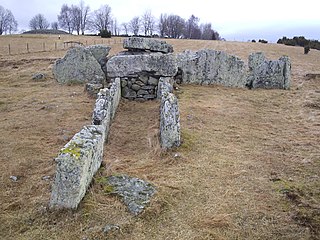 W
WHuman habitation of present-day Sweden began around 12000 BC. The earliest known people belonged to the Bromme culture of the Late Palaeolithic, spreading from the south at the close of the Last Glacial Period. Neolithic farming culture became established in the southern regions around 4000 BC, but much later further north. About 1700 BC the Nordic Bronze Age began in the southern regions, based on imported metals; this was succeeded about 500 BC by the Iron Age, for which local ore deposits were exploited. Cemeteries are known mainly from 200 BC onward.
 W
WEkornavallen is an ancient burial ground in the Falköping Municipality in Sweden. It contains a variety of ancient monuments dating from the Stone, Bronze and Iron Ages.
 W
WJordbro Grave Field is located in Haninge kommun in the southern part of Stockholm County, Sweden. It is thought to be the largest grave field dating from the Iron Age in the Nordic Countries. It is situated south of the small town of Jordbro, roughly one kilometer from Jordbro train station, or approximately one and a half kilometers north of Västerhaninge municipality station. Southeast of the grave field is Gullringskärret nature preserve.
 W
WKalvträskskidan is among the oldest skis ever found. It was found in the autumn of 1924, as a group of men digging a ditch through a mire near the village of Kalvträsk close to Skellefteå, Sweden encountered some wooden objects at a depth of 1.5 metres. They carefully extracted the objects that turned out to be two skis measuring 204 cm by 15.5 cm and a shovel shaped ski pole measuring 156 cm. The objects were kept in a shed that winter before being turned into a museum the following summer. By that time one of the skis had started to wither and fall apart, so that only a few fragments of it remain. Thankfully the other ski is still more or less intact.
 W
WLau is a populated area, a socken, on the Swedish island of Gotland. It comprises the same area as the administrative Lau District, established on 1 January 2016. Originally an island, it is now part of the main Gotland island due to the isostasy. It is mostly known for the good water from the spring Lau Käldu.
 W
WPilane in Klövdal, Tjörn, Bohuslän, Sweden, is an Iron Age settlement site and grave field, dated to 1-600 AD. The grave field consists of approximately 90 ancient monuments, including stone circles, burial mounds, circular stone grave markers and standing stones. The site is under the care of the Swedish National Heritage Board and the land is leased as sheep pasture.
 W
WRunestone U 582 is a runestone that used to be located by the church of Söderby-Karl, Norrtälje municipality in the Roslagen area on the east coast of Sweden. It has been lost since some time before 1830. The runestone has been dated to the 11th century and includes what is probably the oldest written mention of Finland.
 W
WThe Sitones were a Germanic people living somewhere in Northern Europe in the 1st century CE. They are only mentioned by Cornelius Tacitus in 97 CE in Germania. Tacitus considered them similar to Suiones apart from one descriptor, namely that women were the ruling sex.Upon the Suiones, border the people Sitones; and, agreeing with them in all other things, differ from them in one, that here the sovereignty is exercised by a woman. So notoriously do they degenerate not only from a state of liberty, but even below a state of bondage.
 W
WStenkyrka is a populated area, a socken, on the Swedish island of Gotland. It comprises the same area as the administrative Stenkyrka District, established on 1 January 2016.
 W
WTofta, also known as Gotlands Tofta, is a populated area, a socken, on the Swedish island of Gotland. It comprises the same area as the administrative Tofta District, established on 1 January 2016.
 W
WIn Swedish prehistory, the Vendel Period (550–790) comes between the Migration Period and the Viking Age. The migrations and upheaval in Central Europe had lessened somewhat, and two power regions had appeared in Europe: the Merovingian kingdom and the Slavic princedoms in Eastern Europe and the Balkans. A third power, the Catholic Church, had begun to expand its influence.